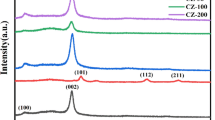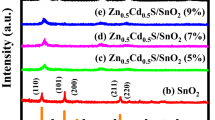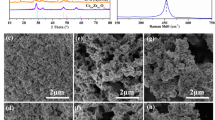Abstract
g-C3N4/ZnxCd(1-x)S composites were synthesized by a simple hydrothermal method. The composites were characterized by X-ray diffraction, UV–vis diffuse reflectance spectroscopy, infrared spectroscopy, and electron micro-projective microscopy. According to the performance of ZnxCd(1-x)S for the photocatalytic degradation of norfloxacin under visible light in water, the best stoichiometric number of x was 0.5. The best photolytic norfloxacin degradation rate of g-C3N4/ZnxCd(1-x)S composites was 89.8%, which was obtained when the dosage ratio of g-C3N4 to ZnxCd(1-x)S was 1:1. The experiment was conducted to investigate the effect of pH on the catalyst to obtain the optimal NORF degradation environment pH in the range of 7 ± 0.3; by simulating the anions that may be contained in the actual environmental water, the results showed that the catalyst has a certain effect on the degradation of NORF when the water contains NO3−, Cl− and HCO3−. In addition, this study also obtained that the main active substances produced by the catalyst during degradation were electron–hole pairs by adding different trapping agents in the NORF removal experiments; and the catalyst was able to achieve a degradation rate of 86.1% after four cycles of the experiments, which proved that it had good stability.








Similar content being viewed by others
Data availability
All relevant data are within the paper. All data supporting the findings of this study are available within the paper and its Supplementary Information.
References
Baaloudj O et al (2021) Synthesis and characterization of ZnBi2O4 nanoparticles: photocatalytic performance for antibiotic removal under different light sources. Appl Sci (Basel) 11(9)
Bai T et al (2021) g-C3N4/ZnCdS heterojunction for efficient visible light-driven photocatalytic hydrogen production. RSC Adv 11(60):38120–38125
Cao Di et al (2018) Enhanced photoelectrocatalytic degradation of norfloxacin by an Ag3PO4/BiVO4 electrode with low bias. J Catal 360:240–249
Chen Q et al (2021) Optimization of photocatalytic degradation conditions and toxicity assessment of norfloxacin under visible light by new lamellar structure magnetic ZnO/g-C3N4. Ecotoxicol Environ Saf 225:112742
Dai X et al (2014) Coupled systems for selective oxidation of aromatic alcohols to aldehydes and reduction of nitrobenzene into aniline using CdS/g-C3N4 photocatalyst under visible light irradiation. Appl Catal B 158–159:382–390
Ding C et al (2022) Mesoporous structure and amorphous Fe-N sites regulation in Fe-g-C3N4 for boosted visible-light-driven photo-Fenton reaction. J Colloid Interface Sci 608:2515–2528
Duan L et al (2022) Titanium oxide improves boron nitride photocatalytic degradation of perfluorooctanoic acid. Chem Eng J 448:137735
Guo H et al (2020) Highly efficient CH3OH production over Zn0.2Cd0.8S decorated g-C3N4 heterostructures for the photoreduction of CO2. Applied Surface Science 528:146943
Hu S et al (2014) Enhanced visible light photocatalytic performance of g-C3N4 photocatalysts co-doped with iron and phosphorus. Appl Surf Sci 311:164–171
Huang Y et al (2017) Synthesis of GO-modified Cu2O nanosphere and the photocatalytic mechanism of water splitting for hydrogen production. Int J Hydrogen Energy 42(7):4007–4016
Kenfoud H et al (2021) Structural and electrochemical characterizations of Bi12CoO20 sillenite crystals: degradation and reduction of organic and inorganic pollutants. J Mater Sci: Mater Electron 32(12):16411–16420
Khan MA et al (2017) Evidence of plasmonic induced photocatalytic hydrogen production on Pd/TiO2 upon deposition on thin films of gold. Catal Lett 147:811–820
Kuecken S et al (2017) Fast tuning of covalent triazine frameworks for photocatalytic hydrogen evolution. Chem Commun 53(43):5854–5857
Lee WC et al (2017) Bismuth sulphide-modified molybdenum disulphide as an efficient photocatalyst for hydrogen production under simulated solar light. Catal Commun 98:66–70
Lee G-J, Zheng Y-C, Wu JJ (2018) Fabrication of hierarchical bismuth oxyhalides (BiOX, X=Cl, Br, I) materials and application of photocatalytic hydrogen production from water splitting. Catal Today 307:197–204
Li Y et al (2018) Rapid fabrication of SnO2 nanoparticle photocatalyst: computational understanding and photocatalytic degradation of organic dye. Inorganic Chemistry Frontiers 5(12):3005–3014
Li Y et al (2019) Unique photocatalytic activities of transition metal phosphide for hydrogen evolution. J Colloid Interface Sci 541:287–299
Li J et al (2021) Improving photocatalytic activity by construction of immobilized Z-scheme CdS/Au/TiO2 nanobelt photocatalyst for eliminating norfloxacin from water. J Colloid Interface Sci 586:243–256
López-Tenllado FJ et al (2017) A comparative study of hydrogen photocatalytic production from glycerol and propan-2-ol on M/TiO2 systems (M=Au, Pt, Pd). Catal Today 280:58–64
Lu L et al (2017) Photocatalytic hydrogen production over solid solutions between BiFeO3 and SrTiO3. Appl Surf Sci 391:535–541
Park SS et al (2011) Facile synthesis of mesoporous carbon nitrides using the incipient wetness method and the application as hydrogen adsorbent. J Mater Chem 21(29):10801–10807
Pilarski M et al (2018) Layered cesium copper titanate for photocatalytic hydrogen production. Appl Catal B 227:349–355
Raaja Rajeshwari M, Kokilavani S, Sudheer Khan S (2022) Recent developments in architecturing the g-C3N4 based nanostructured photocatalysts: synthesis, modifications and applications in water treatment. Chemosphere 291:132735
Reddy NR et al (2018) Enhanced photocatalytic hydrogen production activity of noble metal free MWCNT-TiO 2 nanocomposites. Int J Hydrogen Energy 43(8):4036–4043
Sadovnikov SI et al (2017) Photocatalytic hydrogen evolution from aqueous solutions on nanostructured Ag2S and Ag2S/Ag. Catal Commun 100:178–182
Shen H et al (2009) Phosphine-free synthesis of high quality ZnSe, ZnSe/ZnS, and Cu- Mn-doped ZnSe nanocrystals. Dalton Trans 47:10534–10540
Wang S et al (2020) Selective sensing of Mn2+ based on ZnCdS/ZnS QD/carboxymethyl chitosan/g-C3N4 nanosheet nanocomposite film by the conformational regulation of polymer chain. Appl Surf Sci 530:147255
Wu Z et al (2022) High-performance photodegradation of norfloxacin enabled by AgI@Ag3PO4 nanostructures. J Alloy Compd 891:161877
Yan SC, Li ZS, Zou ZG (2009) Photodegradation performance of g-C3N4 fabricated by directly heating melamine. Langmuir 25(17):10397–10401
Yu L et al (2022) High efficient and stable Z-scheme g-C3N4/Zn0.5Cd0.5S photocatalyst driven by visible light for hydrogen evolution. Mater Sci Eng: B 286:116062
Zeghioud H et al (2021) Combining photocatalytic process and biological treatment for Reactive Green 12 degradation: optimization, mineralization, and phytotoxicity with seed germination. Environ Sci Pollut Res 28(10):12490–12499
Zeng Z et al (2018) Structuring phase junction between tri-s-triazine and triazine crystalline C3N4 for efficient photocatalytic hydrogen evolution. Appl Catal B 227:153–160
Zhang J et al (2013) Efficient visible-light photocatalytic hydrogen evolution and enhanced photostability of core/shell CdS/g-C3N4 nanowires. ACS Appl Mater Interfaces 5(20):10317–10324
Zhang J et al (2017) High efficiency and stable tungsten phosphide cocatalysts for photocatalytic hydrogen production. J Mater Chem A 5(24):12513–12519
Funding
This work was supported by the Natural Science Foundation of Anhui Province (grant 2008085MB57) and Natural Science Research Key Project from Education Department of Anhui Province (grant KJ2021A0626).
Author information
Authors and Affiliations
Contributions
Conceptualization: SW; methodology: ZW and QC; formal analysis and investigation: ZW and QC; writing—original draft preparation: ZW; writing—review and editing: SW; and funding acquisition: SW.
Corresponding author
Ethics declarations
Competing interests
The authors declare no competing interests.
Additional information
Responsible Editor: George Z. Kyzas
Publisher's Note
Springer Nature remains neutral with regard to jurisdictional claims in published maps and institutional affiliations.
Rights and permissions
Springer Nature or its licensor (e.g. a society or other partner) holds exclusive rights to this article under a publishing agreement with the author(s) or other rightsholder(s); author self-archiving of the accepted manuscript version of this article is solely governed by the terms of such publishing agreement and applicable law.
About this article
Cite this article
Wu, Z., Chen, Q. & Wu, S. Photocatalytic degradation of norfloxacin antibiotics on ZnxCd(1-x)S/g-C3N4 composites in water. Environ Sci Pollut Res 31, 16473–16484 (2024). https://doi.org/10.1007/s11356-024-32238-9
Received:
Accepted:
Published:
Issue Date:
DOI: https://doi.org/10.1007/s11356-024-32238-9




